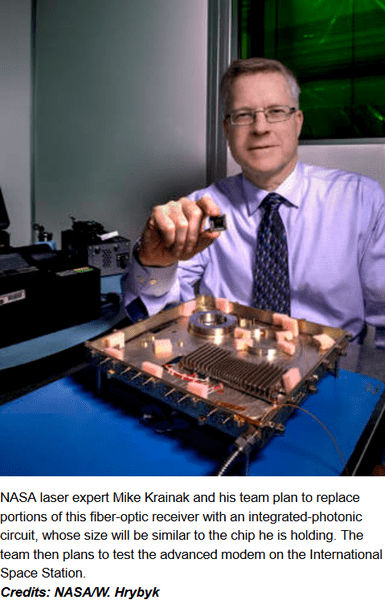NASA To Build World’s First Integrated Photonics Modem
NASA has been reportedly developing the world’s first integrated-photonic communication modem, that would eventually power various sectors including telecommunication, imaging, and manufacturing. The IP modem will be tested above the earth’s surface, in the International Space Station by the year 2020. NASA explained this new expedition is an integral part of NASA’s multi-year Laser Communications Relay Demonstration aka LCRD.
Once placed and set to work, LCRD LEO (Low-Earth Orbit) User Modem and Amplifier (ILLUMA) will expectedly demonstrate record performance in high-speed laser-based communications. Since 1958, NASA relied on Radio frequency based communication. According to Don Cornwell, director of NASA’s Advanced Communication and Navigation Division within the space Communications and Navigation Program, owing to high demanding data rates, the advancement of technology became crucial and eventually led to the newest IP based modem. The tiny device is stuffed with coherent optical sources such as Lasers, switches and wires which are all embedded on a microchip similar to IC technology. LCRD modems will use lasers to encode and transmit data at rates 10 to 100 times faster than other contemporary technologies.

The lesser mass and power requirements along with higher data speeds would help in producing high-resolution videos and measurements taken from spacecrafts on planets across the solar system. ILLUMA is an emerging technology based on integrated photonics that replaces standard fibre optic cables used for internet communication.
Similar to electrons in integrated circuits, IP circuits make use of photons as the carrier element of circuits. Recent developments in nanostructures, meta-materials and silicon technologies expanded the range of application for IP chips.
Mike Krainak, leader of the modem’s development team at NASA’s Goddard Space Flight Center in Greenbelt at Maryland explained that the new technology would produce communication systems with enhanced reliability and better functionality. Their main goal is to produce low-cost, high-volume, manufacturing methods to merge electronic integrated circuits with integrated photonic devices.
Krainak added that switching to photonics will eventually improvise space craft equipments and the study of planetary sciences. The concept could also be implemented in intra-Earth communication to ultra-modernize the contemporary systems. He has claimed that due to such a board spectrum of advantages tech giants like Google and Facebook are also considering about transforming to IP technology.
Watch Boson sampling using integrated photonics circuits:
Source: #-Link-Snipped-#
Once placed and set to work, LCRD LEO (Low-Earth Orbit) User Modem and Amplifier (ILLUMA) will expectedly demonstrate record performance in high-speed laser-based communications. Since 1958, NASA relied on Radio frequency based communication. According to Don Cornwell, director of NASA’s Advanced Communication and Navigation Division within the space Communications and Navigation Program, owing to high demanding data rates, the advancement of technology became crucial and eventually led to the newest IP based modem. The tiny device is stuffed with coherent optical sources such as Lasers, switches and wires which are all embedded on a microchip similar to IC technology. LCRD modems will use lasers to encode and transmit data at rates 10 to 100 times faster than other contemporary technologies.

The lesser mass and power requirements along with higher data speeds would help in producing high-resolution videos and measurements taken from spacecrafts on planets across the solar system. ILLUMA is an emerging technology based on integrated photonics that replaces standard fibre optic cables used for internet communication.
Similar to electrons in integrated circuits, IP circuits make use of photons as the carrier element of circuits. Recent developments in nanostructures, meta-materials and silicon technologies expanded the range of application for IP chips.
Mike Krainak, leader of the modem’s development team at NASA’s Goddard Space Flight Center in Greenbelt at Maryland explained that the new technology would produce communication systems with enhanced reliability and better functionality. Their main goal is to produce low-cost, high-volume, manufacturing methods to merge electronic integrated circuits with integrated photonic devices.
Krainak added that switching to photonics will eventually improvise space craft equipments and the study of planetary sciences. The concept could also be implemented in intra-Earth communication to ultra-modernize the contemporary systems. He has claimed that due to such a board spectrum of advantages tech giants like Google and Facebook are also considering about transforming to IP technology.
Watch Boson sampling using integrated photonics circuits:
Source: #-Link-Snipped-#
Replies
-
 sagar pise😀
sagar pise😀
You are reading an archived discussion.
Related Posts
On a very short notice, I found that I have to select one optional elective between biomedical instrumentation engineering and Soft computing in my 6th semester electronics and instrumentation course....
Less than five months after the launch of Canvas Juice 3, Micromax is planning to launch its successor, the Canvas Juice 4. The Micromax Canvas Juice 4 has surfaced on...
Project Abstract / Summary : This project is a new approach of speaking to the computer to create text documents in various Indian languages. A speech synthesizer and a speech...
Google has ventured into almost every market there is, and their new Google Fiber project is an extension of Project Fi, its cellular service backed by Sprint and T-Mobile networks....
In order to combat growing popularity of live video broadcasting mobile apps like Meerkat and Twitter’s Periscope, Facebook has now opened its live video sharing option to all iPhone users...
